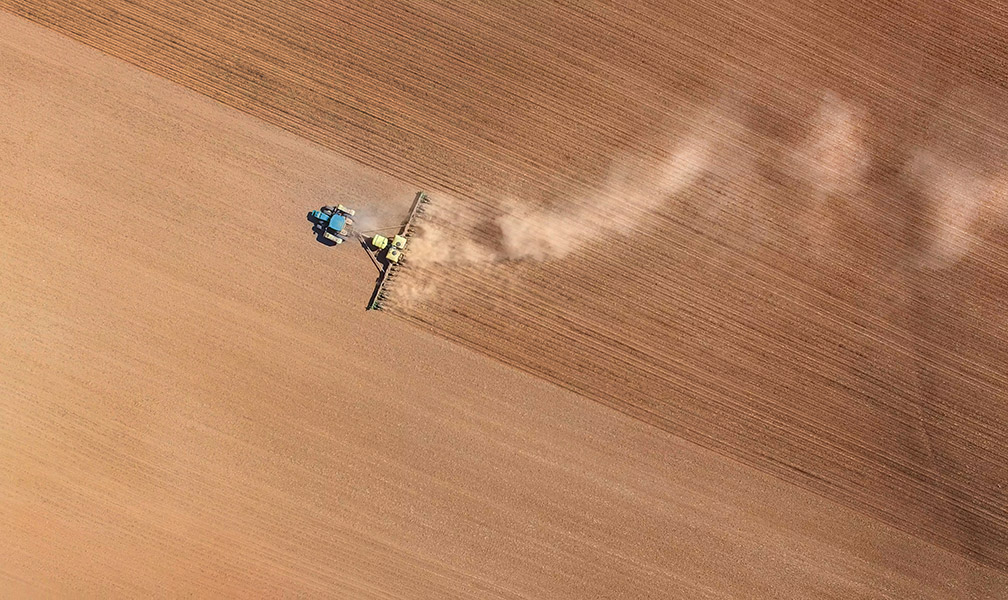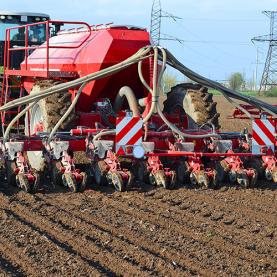Intensive farming
Faced with a growing need for food around the world, in order to increase productivity, farms gradually introduced industrial methods to augment yield per unit of labour and per hectare. Intensive farming used various means based on technological and scientific innovations, such as phytosanitary products, selection of varieties, and genetic engineering, to improve the performance of soils, plants and livestock.
Profitable and productive, but with an impact on the environment, society and health
In the West of the early 20th century, agriculture mainly consisted of small and medium-sized farms practising polyculture using animal traction. In the latter half of the 20th century, this type of farming changed and smallholdings were replaced by specialist large-scale commercial farms using powerful agricultural machinery as well as fertilisers and synthetic pesticides on immense expanses of farmland. This change resulted from a political desire to increase agricultural productivity in order to meet a growing need for food around the world. After the Second World War, most industrialised countries embraced policies that favoured intensive farming, making use of technological and scientific progress in the mechanical and chemical industries as well as in genetics. These policies encouraged the flux of products and advantageous and relatively stable prices, while favouring the purchase of new means of production via subsidies and credit systems with low interest rates for farmers, and encouraging unprofitable farms to close down. In the interwar years, motorised tractors gradually replaced traction animals. From the 1950s, machines became ever more powerful and advanced, as with self-loading trailers, fertiliser spreaders, and rotary harrows, for example. Such innovations made farmers’ work less strenuous and favoured large-scale farms with a smaller workforce. In addition to this, genetic engineering intensified and rationalised the century-old processes of hybridisation and varietal selection. Scientists created new varieties with improved performance and resistance, to thrive in different physical or biological environments.
The 19th century saw the invention of chemical fertilisers to compensate for the lack of available organic fertilisers. They became more common from the 1950s onwards and helped boost harvests. Similarly, pesticides (herbicides, insecticides and fungicides) made crop farmers’ work easier by eliminating weeds and unwanted insects, and protecting plants from disease. All these transformations helped improve the performance of soils, plants and livestock, and increase yields per unit of labour and per hectare. However, intensive farming amplifies social and economic disparities as it only promotes progressive enterprises and regions, while those in a less favourable position, with limited capital and yield, do not receive subsidies enabling them to invest and develop, and hence have to cease activity. Moreover, large-scale and excessive use of phytosanitary and zoosanitary products, fertilisers and heavy machinery eventually creates environmental problems such as desertification, water pollution, reduced biodiversity, soil compaction, and the destruction of some species’ habitats. With regard to health, long-term exposure to certain pesticides, whether synthetic or not, may increase the risk of developing cancers, neurological diseases and reproductive disorders.
Identifying such impacts, especially from an ecological point of view, combined with the continuing need to produce sufficient food, has prompted a search for solutions. Ideally, these would ensure high productivity while rationalising the use of existing fertilisers and phytosanitary products as much as possible, as well as researching phytosanitary products that are more effective at lower concentrations. Solutions involving genetic engineering have already been developed and marketed, yet raise opposition among the general public, concerned that the risks involved in using genetically modified organisms (GMOs) in food production have not yet been examined in sufficient detail.
BAIROCH, Paul, 1989. Les trois révolutions agricoles du monde développé : rendements et productivité de 1800 à 1985. Annales. Économies, Sociétés, Civilisations. 1989. n°2, pp. 317-353. doi : 10.3406/ahess.1989.283596
FRIOUD, Élise.2013. Les OGM continuent à faire débat [en ligne]. Agrihebdo.[Consulté le 16 mars 2017]. Disponible à l’adresse : http://www.agrihebdo.ch/genie
MATTMÜLLER, Markus, INEICHEN, Andreas, 2011. Engrais [en ligne]. DHS І Dictionnaire Historique Suisse [Consulté le 16 mars 2017]. Disponible à l’adresse : http://www.hls-dhs-dss.ch/textes/f/F13856.php
MAZOYER, Marcel, ROUDART, Laurence, 1997. Histoire des agricultures du monde. Du néolitique à la crise contemporaine. Paris : Seuil.
OMS І Organisation mondiale de la Santé, 2005. Biotechnologie alimentaire moderne, santé et développement : étude à partir d'exemples concrets Impacts sur la santé [en ligne] Genève : OMS. [Consulté le 17 mars 2017]. Disponible à l’adresse : http://www.who.int/foodsafety/publications/biotech/biotech_fr.pdf
PERVANCHON, Frank, BLOUET, André, NGUYEN, Geneviève, SARTHOU, Jean-Pierre, FÉRET, Samuel, 2002. Lexique des qualificatifs de l'agriculture [en ligne]. Courrier de l'environnement de l'INRA. Février 2002. n°45. pp. 117-136. [Consulté le 16 mars 2017]. Disponible à l’adresse : https://hal.archives-ouvertes.fr/hal-01202642/file/C45Blouet.pdf
ROVILLÉ, Manuelle, 2008. Agriculture intensive et déforestation au banc des accusés [en ligne]. CNRS/sagascience. [Consulté le 16 mars 2017]. Disponible à l’adresse : http://www.cnrs.fr/cw/dossiers/dosbiodiv/?pid=decouv_chapC_p3_d1&zoom_id=zoom_d1_1
ROVILLE, Manuelle, AUFRAY, Renan, 2008. Modes de gestion agricole et influences sur la biodiversité du sol [en ligne]. CNRS/sagascience. [Consulté le 16 mars 2017]. Disponible à l’adresse : http://www.cnrs.fr/cw/dossiers/dosbiodiv/?pid=decouv_chapC_p5_d1&zoom_id=zoom_d1_2
TISSIER, Maryvonne, 2008. Agriculture productiviste : et la biodiversité dans tout ça ? [en ligne]. CNRS/sagascience. [Consulté le 16 mars 2017]. Disponible à l’adresse : http://www.cnrs.fr/cw/dossiers/dosbiodiv/?pid=decouv_chapC_p4_d1&zoom_id=zoom_d1_6
TISSIER, Maryvonne, 2008. OGM, alimentation, polémique [en ligne]. CNRS/sagascience [Consulté le 16 mars 2017]. Disponible à l’adresse : http://www.cnrs.fr/cw/dossiers/dosbiodiv/?pid=decouv_chapC_p4_d1&zoom_id=zoom_d1_8







